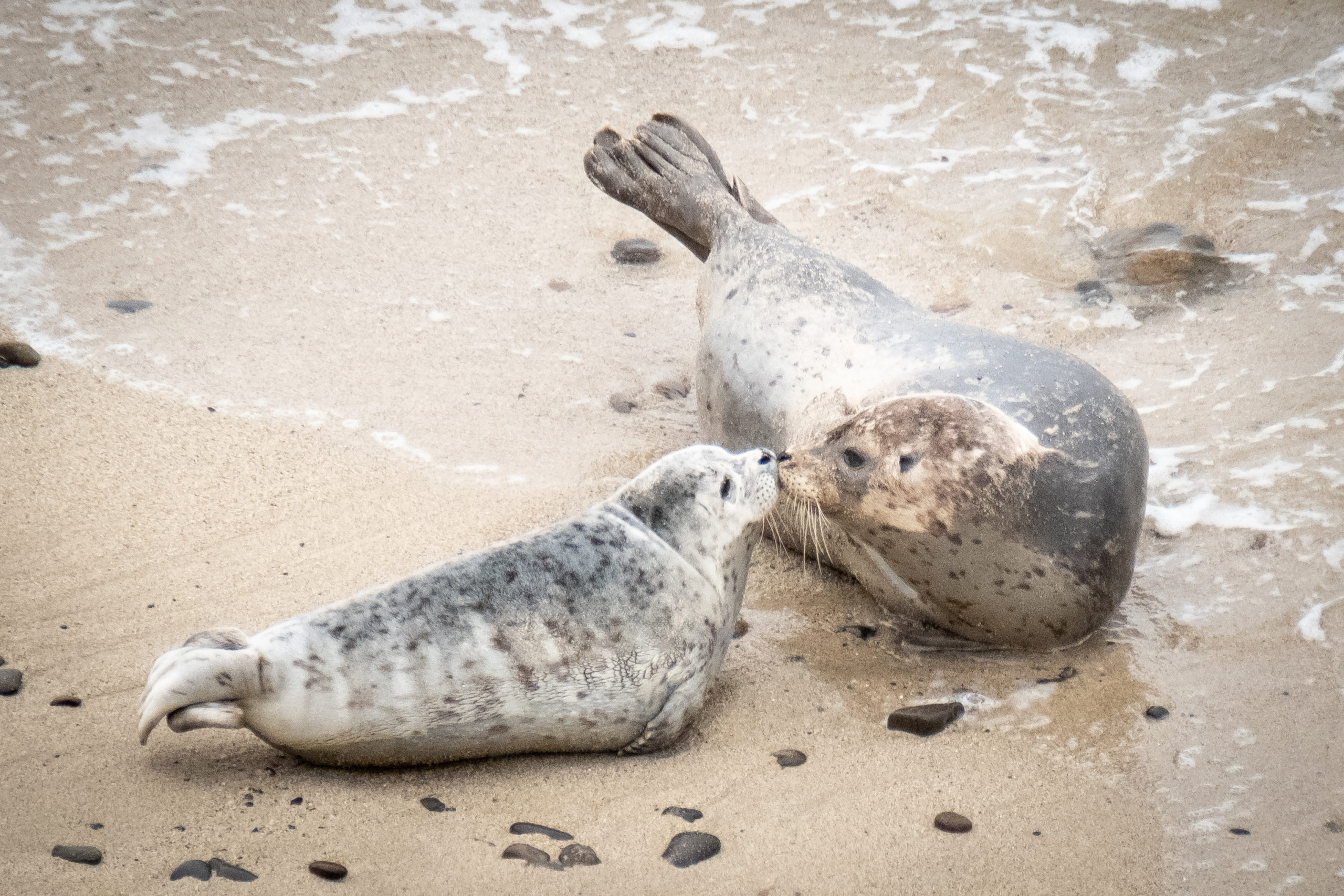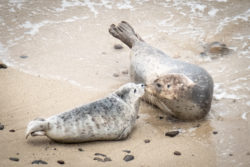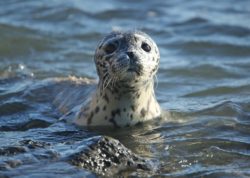
Sea Wonder: Harbor Seal
Known as the common seal due to how widespread they are throughout the world, harbor seals (Phoca vitulina) make use of beaches, rocky shores, glacial ice, and mudflats throughout the Northern hemisphere. They spend at least half their time in the water and are often water-side so they can make a quick escape.

Mom and pup harbor seal in Monterey Bay National Marine Sanctuary. Photo: Clarice Soleil
Description
Harbor seals are “true seals”, meaning they do not have external ear flaps and cannot use their hind flippers to walk on land. Pups weigh about 24 pounds at birth and grow to weigh nearly 300 pounds as adults. They can measure nearly six feet in length, and males tend to be larger than females. They have rounded faces, dog-like snouts, long and thick whiskers called vibrissae that cover their snout and above their eyes, and several types of teeth, including canines and incisors.
Their bodies are thick and blubbery and they have two pairs of flippers, one toward the front of their body called foreflippers and the other toward the end of their body, called hind flippers. The foreflippers are webbed with five bony digits that have short claws; the seals use these flippers for steering themselves underwater. The hind flippers are also webbed with five bony digits, but they are longer than the foreflippers and do not have claws; they move these flippers side to side to swim as fast as 12 miles per hour.
Harbor seals have thick coats of fur that range from silver-gray to black and dark brown, and each seal has a unique pattern of spots and coloration based on their genetics and the time of tear. They molt (gradually shed and replace their fur) annually after the spring breeding season, revealing a fresh coat after a month or two.
Diet & Habitat
Harbor seals are carnivores that rely on fish, squid, crustaceans, and shellfish. They are opportunistic feeders, which means they feed on whatever is easiest to find and catch, and they can hunt in shallow or deep waters due to their ability to hold their breaths as long as 30 minutes and achieve dives to depths of nearly 1,600 feet! Seal pups nurse from their mothers for about a month after birth to help them gain weight quickly (the milk they drink is more than 50 percent fat!), then they are weaned as they learn to eat solid foods on their own. Polar bears, killer whales, and sharks are the harbor seal’s primary natural predators.

Rehabilitated harbor seal pup in Monterey Bay National Marine Sanctuary. Photo: Rob Cala.
Harbor seals live in temperate coastal areas in the northern hemisphere. They are widely distributed along the coasts of North America Europe, and Asia. On America’s east coast, harbor seals live as far north as Canada and as far south as the Carolinas, and on the west coast from Alaska to southern California. They can haul out on ice sheets, rocky coasts, mudflats, and sandy beaches and are not migratory, though they can sometimes travel hundreds of miles from their home range in search of food. They prefer coastal waters but can and do venture into freshwater habitats, including rivers and lakes. We see harbor seals throughout the National Marine Sanctuary System, including all of the sites in California, Stellwagen Bank, and even Gray’s Reef in the Gulf of Mexico.
Life History
Harbor seals breed and give birth during the warmer months of the year, though the exact timing varies by a population’s exact location. A harbor seal pregnancy lasts approximately 10 months and they generally give birth to one pup at a time; females can give birth every year. Mothers and pups live together in nursery groups while they nurse their young and teach them important seal skills before weaning them four to six weeks later. These seals reach sexual maturity when they reach their full size, which is around 3 to 7 years old. The longest living harbor seals can reach 35 years old, though the average is closer to 20.
Harbor seals are fairly solitary even though they haul out in groups for protection from predators and are commonly seen near other species of pinnipeds like California sea lions and elephant seals. They don’t make many vocalizations and are often resting when they are on land, which people often mistake for sickness or injury.
Threats & Conservation
Harbor seal populations around the world are considered stable and a species of least concern as it relates to extinction, but this was not always the case. Some human cultures have hunt the occasional seal for survival in colder climates, but the real threat to harbor seals came with the industrial revolution and new technologies. Harbor seals were seen as a threat to fisheries, especially in the U.S., which led to seal culling in large numbers. The official seal hunting program in the U.S. ended in the 1960s and harbor seals now receive federal protections under the Marine Mammal Protection Act of 1972. Harbor seals do still face anthropogenic threats like reduced food availability due to fishing, ocean acidification, and a warming ocean, entanglement in fishing gear, habitat destruction, and anthropogenic noise.
If you ever see a seal on the beach or coastline and are unsure if it is safe or injured, do not approach it, the animal may be resting, and if it is sick or injured it could be aggressive due to fear. Keep the animal in your sight, maintain your distance, take photos, make a note of your specific location, and report what you see to the National Marine Fisheries Service’s official Marine Mammal Hotline. NOAA will then work with the nearest marine mammal rescue organization to assess the situation and respond if necessary.
